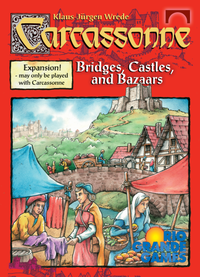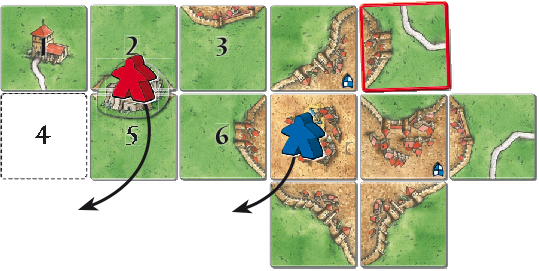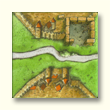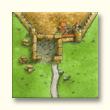Bruggen, Burchten en Bazaars (1e editie)
Rio Grande Games |
Z-Man Games |
Algemene informatie en opmerkingen
Burchten, bruggen en markten werd oorspronkelijk in 2010 uitgegeven door Hans im Glück.
Dit is de achtste grote uitbreiding voor Carcassonne en introduceert enkele nieuwe aspecten in het spel. Rondtrekkende handelaars komen in het land en organiseren markten, waarbij handjeklap tot een kunst wordt verheven. Tegelijkertijd breiden ingenieurs het wegennet uit met moderne bruggen en worden er overal kleine burchten gebouwd om de regio te verdedigen.
De nieuwe items zijn:
- Bruggen
- Burchten
- Markten
Een Carcassonne-uitbreiding is geen echte Carcassonne-uitbreiding als er geen nieuwe tegels bij zitten en dus vind je in de doos 12 tegels met stadsdelen, wegdelen en kloosters in nieuwe combinaties plus op sommige tegels de markten waarmee een nog mooier speelveld gemaakt kan worden.
Speelmateriaal
- 12 nieuwe landschapstegels
- 12 burchten
- 12 houten bruggen
Spelregels
Voorbereiding
De twaalf nieuwe landtegels dienen door die van het basisspel geschud te worden. Tijdens he spel worden ze volgens de normale spelregels getrokken en aangelegd.
Iedere speler ontvangt, afhankelijk van het aantal spelers, bruggen en burchten en wel:
- in een spel met twee tot vier spelers, ontvangt iedere speler 3 bruggen en 3 burchten;
- in een spel met vijf of zes spelers, ontvangt iedere speler 2 bruggen en 2 burchten.
Alle spelregels van Carcassonne blijven, met uitzondering van onderstaande aanvulingen, gelden.
Landtegel leggen
De spelers trekken tegels en leggen die volgens de gebruikelijke spelregels aan. [1]
De markt
Als er een tegel met een markt wordt getrokken, legt de speler die zoals gebruikelijk aan (inclusief het zetten van een horige, een puntentelling, of niet als er geen plaats is waar dat kan). [2] [3]
Daarna vindt de markt plaats waarbij landschapstegels worden geveild.
De speler die aan de beurt is trekt zoveel tegels als er spelers zijn en legt die open. Nu zoekt de volgende speler één van de tegels uit en zegt hoeveel punten hij biedt om deze tegel te verkrijgen (een speler kan ook 0 punten bieden!). Om de beurt, met de wijzers van de klook mee, komen nu alle spelers éénmaal aan de beurt. Ofwel verhoogt een speler het bestaande bod, ofwel hij past.
Als alle spelers hebben geboden of gepast, moet de speler die de tegel heeft uitgezocht een keuze maken:
- de tegel kopen van de hoogste bieder en deze hiervoor de geboden punten te geven, OF
- de tegel aan de hoogste bieder verkopen en de geboden punten van hem ontvangen.
Hierbij wordt het puntentotaal voor de ene speler op de scoretabel verminderd en voor de andere speler verhoogd. Als de speler die de tegel gekozen had ook de enige is die een bod heeft gedaan, dan worden de geboden punten alleen van zijn puntentotaal afgehaald, maar niet aan een andere speler toegekend. Spelers mogen meer punten bieden dan ze hebben en hun telsteen achter de 0 op scoretabel zetten. In dit geval kunnen ze de telsteen plat leggen om aan te geven dat deze negatief is. [4] [5]
Daarna is de volgende speler aan de beurt die nog op de markt nog geen tegel heeft verkregen. [6] Spelers die al een tegel ontvangen hebben mogen niet meer meebieden. De laatste tegel gaat gratis naar de speler die nog geen tegel heeft gekocht.
Nadat alle tegels zijn geveild, leggen alle spelers de tegels die ze gekocht hebben om de beurt aan, zoals in een normale beurt. [7] De linkerbuurman van de speler die aan de beurt is begint.
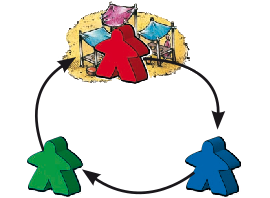
Rod trekt een tegel met een markt. Zij legt deze tegel aan en zet één van haar horigen op deze tegel. Daarna legt zij drie landschapstegels open.
* Blauw is de volgende speler die aan de beurt is en hij kiest een tegel uit waarvoor hij 2 punten biedt. Groen past en rood biedt 3 punten. Blauw (de veilingmeester) wil de tegel graag houden en betaalt dus 3 punten aan rood (de meest biedende). Dit betekent dat blauw zijn puntentotaal vermindert met 3 en dat rood haar puntentotaal met 3 verhoogt.
* Nu zoekt groen een tegel uit en hij biedt 2 punten. Rood biedt 3 punten, blauw mag niet meer bieden. Groen geeft haar de tegel en ontvangt de 3 punten. Het puntentotaal van rood wordt met 3 punten verminderd.
* Nu is er nog maar één tegel over die groen gratis krijgt.
Te beginnen met blauw leggen alle spelers hun geveilde kaart aan, zoals in een normale speelbeurt.
Te weinig tegels: Als een speler een markttegel aanlegt en er zijn niet genoeg gedekte tegels voor alle spelers, vindt er geen tegelveiling plaats. De markt op de tegel wordt verder genegeerd en de tegel wordt zoals gebruikelijk gespeeld. [8]
Geen kettingreactie: Als door het aanleggen van een markttegel er een andere markttegel gekocht en aangelegd wordt, worden er geen aanvullende tegels opengelegd en geveild. Pas nadat alle geveilde tegels aangelegd zijn, kan er een nieuwe marktveiling plaatsvinden. [9]
Variation: As many tiles should be uncovered as there are players. Beginning with the next player, in turn each player selects one of the tiles and places it as in a normal turn. This continues until all the uncovered tiles have been allocated, and then the game continues as normal. [10] [11]
![]() Vraag: What is the order of events if the bazaar tile extends a feature with a builder?
Vraag: What is the order of events if the bazaar tile extends a feature with a builder?
If you draw a bazaar tile and can perform your builder-turn, first take the appropriate number of face-down tiles and perform the bazaar and the auction. Then a new round with a special property starts – each player has an open and known tile instead of drawing an unknown tile, and you cannot place your abbey as your first tile. If you placed your auctioned tile and you can perform a builder-turn, you can choose to place your abbey or draw a new unknown tile. If any player draws a new bazaar tile [for his or her builder-turn], it will be ignored until the last player who has an auctioned tile finishes his turn (including his builder-turn, if possible). Any pending delayed bazaars will take place now in turn. Once the bazaar rounds are finished, you perform your builder-turn. [12]
In other words:
- Draw bazaar and perform first part of your double turn.
- ** // Start pending bazaars // **
- Draw the tiles (still face-down)
- Turn tiles face-up and perform the auction
- ( Start delaying any new bazaars )
- 1st Player with auctioned tile (if a bazaar tile, no bazaar is triggered)
- 1st player’s builder-turn, if applicable
- Next player with auctioned tile (if a bazaar tile, no bazaar is triggered)
- Next player’s builder-turn, if applicable
- ...
- Last player with auctioned tile (if a bazaar tile, no bazaar is triggered)
- Last player’s builder-turn, if applicable
- ( Stop delaying any new bazaars )
- Player who drew and placed a new bazaar in his/her builder turn (pending delayed bazaar)
- ** Back to // Start pending bazaars // until no pending delayed bazaars **
- Perform your builder-turn (second part of your double turn)
Bridges
During his or her turn, [13] and in addition to placing a tile and deploying a follower, a player may build one bridge. [14] The bridge continues a road; that is, it carries the road over the tiles and counts exactly the same as a road segment on a land tile. [15] [16]
To build a bridge, the following conditions must be met:
- The bridge may be built on the tile which was just placed, or on an adjacent tile which touches it on one side.
- Both ends of the bridge must lie on a field (not on a city, road, river, or so on).
A player may also place the tile so that a road ends at a farm when he or she then continues the road with a bridge. A follower may be deployed to the tile; if the bridge is built on the tile being placed, the follower may be deployed to the bridge. [17] Farms or cities under a bridge are not divided. Also, several bridges may be built next to each other. [18] [19]
Castles
When a player creates a town – which consists of only two semi-circular city segments [20] [21] – the occupier may choose to complete and score it in the usual way (for 4 points), or to convert it into a castle. [22] [23] To convert it, the occupier places one of his or her castle tokens over the city and moves the follower occupying it into the castle. [24] [25] [26] A town which has been converted to a castle is considered to be incomplete.
No points are scored on building a castle. The player receives points only when the first structure (cloister, city, or road) in its vicinity [27] is completed during a subsequent turn. [28] [29] [30] More precisely, a segment of the structure being completed must be one or more of the tiles adjacent to the castle. The adjacent tiles are the two on which the castle lies, the two tiles to its left, and the two to its right - a total of six tiles.
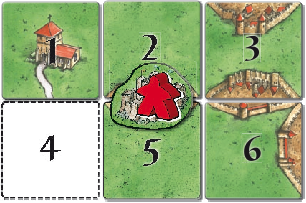
• the CLOISTER on 1
• the ROAD on 1
• the CITY at the top of 3
• the CITY on the right side of 6
(The small city on 3 and 6 was scored before the construction of the castle, and so generates no more points.)
The castle is only considered to have been completed when a structure (cloister, city, road, or another castle) which lies on at least one of the six adjacent tiles is completed. The occupier of the structure and the occupier of the castle both receive the full score [31] for the structure. Then the follower from the castle is returned to the player’s supply; the castle token remains where it is.
The following rules are also valid:
- A cloister is only considered to be adjacent when the cloister itself lies on one of the six tiles (such as tile 1 in the examples above); it is not sufficient for one of the eight tiles surrounding the cloister to be adjacent.
- The follower in the castle always receives points for the next structure to be completed. It may not be left in play in order to receive points for a structure which might be completed later.
- It does not matter whether the structure completed actually scores any points. The castle still receives points for a completed structure which is not occupied by a follower. [32]
- Should the placement of a tile simultaneously complete more than one structure adjacent to the castle, the occupier of the castle may decide which of them to receive points for. [33] A castle receives points for only one completed structure.
- As a town which is converted into a castle is not considered to have been completed, it is possible for two occupied castles to be located next to each other. In this case, when one of the castles score points, it counts as a completed structure for the other, and both receive the same points.
- At game end, all uncompleted castles score no points and their followers are removed from the board. A castle gets no points from farms in its vicinity.
- When converting to a castle, it does not matter whether the small city was already occupied by a follower in the first half of the city, or by the active player deploying a follower to the second half during his or her turn.
- Castles separate fields in the same way as a town does.
- A knight on a castle cannot be attacked by the dragon. [34] [35]
- A player can use the wagon to build a castle. [36] If a mayor is on the castle, it does not earn points for the castle, because there is never a pennant there. [37]
When scoring farmers at game end, a castle on a farm scores 4 points (instead of the 3 usual for a city), or 5 points with a pig (Traders and Builders) or barn (Abbey and the Mayor). [38] [39] [40] [41]
Tegelverdeling
Aantal tegels: 12
Voetnoten
Ga voor licentie en uitleg over de pictogrammen naar de pictogrammen pagina.
- ↑
 De gele grond van een markt is het einde van een weg. Dit is een beetje anders dan kruisingen of struiken aangezien de transportwagen een markt niet mag oversteken naar de andere kant omdat het een project is. (gewijzigd 10/2013)
De gele grond van een markt is het einde van een weg. Dit is een beetje anders dan kruisingen of struiken aangezien de transportwagen een markt niet mag oversteken naar de andere kant omdat het een project is. (gewijzigd 10/2013)
- ↑
 Het gedeelte tussen haakjes komt alleen voor in de spelregels van de editie van RGG en dient als verduidelijking dat de markt aan het einde van de beurt plaatsvindt, na de puntentelling, en niet meteen na het aanleggen van de tegel.
Het gedeelte tussen haakjes komt alleen voor in de spelregels van de editie van RGG en dient als verduidelijking dat de markt aan het einde van de beurt plaatsvindt, na de puntentelling, en niet meteen na het aanleggen van de tegel.
- ↑
 De markt vindt plaats na het trekken en aanleggen. Als de tegel nergens aangelegd kan worden en terzijde gelegd wordt, vindt er dus geen markt plaats. (10/2014)
De markt vindt plaats na het trekken en aanleggen. Als de tegel nergens aangelegd kan worden en terzijde gelegd wordt, vindt er dus geen markt plaats. (10/2014)
- ↑
 In de spelregels van de HiG editie van Big Box 3 is deze zin anders geformuleerd: “Aan het begin van het spel kan het voorkomen dat een speler als gevolg van een veiling minder dan 0 punten heeft.”
In de spelregels van de HiG editie van Big Box 3 is deze zin anders geformuleerd: “Aan het begin van het spel kan het voorkomen dat een speler als gevolg van een veiling minder dan 0 punten heeft.”
- ↑
 In de spelregels van de editie van ZMG staat dat “een speler mag niet meer punten bieden dan hij heeft,” wat een belangrijke afwijking is van de oorspronkelijke spelregel. (5/2014)
In de spelregels van de editie van ZMG staat dat “een speler mag niet meer punten bieden dan hij heeft,” wat een belangrijke afwijking is van de oorspronkelijke spelregel. (5/2014)
- ↑
 De spelregels van de editie van RGG van Big Box 3 voegt hieraan toe: “dat kan dezelfde speler zijn als die de tegel die hij gekozen had niet heeft gekocht.”
De spelregels van de editie van RGG van Big Box 3 voegt hieraan toe: “dat kan dezelfde speler zijn als die de tegel die hij gekozen had niet heeft gekocht.”
- ↑
 Een speler mag een gekochte tegen aan een stad met een bouwmeester neerzetten en een nieuwe tegel trekken voordat de andere spelers hun geveilde tegel spelen aangezien de "dubbele beurt" onderdeel is van een normale beurt.
Een speler mag een gekochte tegen aan een stad met een bouwmeester neerzetten en een nieuwe tegel trekken voordat de andere spelers hun geveilde tegel spelen aangezien de "dubbele beurt" onderdeel is van een normale beurt.
- ↑
 Deze spelregel komt alleen voor in de RGG editie van Big Box 3.
Deze spelregel komt alleen voor in de RGG editie van Big Box 3.
- ↑
 Merk op dat een aangeschafte markttegel geen nieuwe veiling veroorzaakt, maar elke getrokken markttegel wel. Niettemin, zoals besproken in de V&A verheldering, vindt de veiling mogelijk niet onmiddellijk plaats als die tijdens de bouwmeester-beurt binnen een marktronde getrokken werd.
Merk op dat een aangeschafte markttegel geen nieuwe veiling veroorzaakt, maar elke getrokken markttegel wel. Niettemin, zoals besproken in de V&A verheldering, vindt de veiling mogelijk niet onmiddellijk plaats als die tijdens de bouwmeester-beurt binnen een marktronde getrokken werd.
- ↑
 The RGG edition of Big Box 3 adds, “Thus, each player places one tile for no cost - thus, no auction!”
The RGG edition of Big Box 3 adds, “Thus, each player places one tile for no cost - thus, no auction!”
- ↑
 The ZMG edition states that the variant rule should be used if a bazaar tile is drawn and all players have 0 points (as the ZMG rules do not allow negative scores). (5/2014)
The ZMG edition states that the variant rule should be used if a bazaar tile is drawn and all players have 0 points (as the ZMG rules do not allow negative scores). (5/2014)
- ↑
 There is another version of this rule that states that you perform your builder-turn before the bazaar. This discrepancy (originated from the mistranslation of a clarification from 5/2013) was considered a valid alternative by HiG as it doesn't change the game much. The rationale behind the original rule is that the bazaar is an action derived from the tile placed in the first part of the double turn, so it should be resolved before the builder-turn is carried out. (08/2016)
There is another version of this rule that states that you perform your builder-turn before the bazaar. This discrepancy (originated from the mistranslation of a clarification from 5/2013) was considered a valid alternative by HiG as it doesn't change the game much. The rationale behind the original rule is that the bazaar is an action derived from the tile placed in the first part of the double turn, so it should be resolved before the builder-turn is carried out. (08/2016)
 This variant, described in the CAR and implemented by Digital Versions as of 12/2018, may seem more intuitive to some players. It considers the events in the following order:
This variant, described in the CAR and implemented by Digital Versions as of 12/2018, may seem more intuitive to some players. It considers the events in the following order:
- Draw bazaar and perform first part of your double turn.
- ** // Start pending bazaars // **
- Draw the tiles (still face-down)
- ( Start delaying any new bazaars )
- Perform your builder-turn (second part of your double turn)
- Turn tiles face-up and perform the auction
- 1st Player with auctioned tile (if a bazaar tile, no bazaar is triggered)
- 1st player’s builder-turn, if applicable
- Next player with auctioned tile (if a bazaar tile, no bazaar is triggered)
- Next player’s builder-turn, if applicable
- ...
- Last player with auctioned tile (if a bazaar tile, no bazaar is triggered)
- Last player’s builder-turn, if applicable
- ( Stop delaying any new bazaars )
- Player who drew and placed a new bazaar in his/her builder turn (pending delayed bazaar)
- ** Back to // Start pending bazaars // until no pending delayed bazaars **
- ↑
 Of particular note here is that a specific part of the turn for bridge placement is not specified. Obviously one must be placed immediately after tile placement if the tile placement would otherwise be illegal, and a bridge must be placed before a follower if the follower is to be placed on the bridge. However, one could envision a situation where the bridge is not needed for tile placement (e.g. a straightforward attachment on 1 edge) but for strategic reasons the player later in the turn opts to place a bridge on that tile (or even the adjacent one) such that the bridge ends are on tile edges that do not touch other tiles.
Of particular note here is that a specific part of the turn for bridge placement is not specified. Obviously one must be placed immediately after tile placement if the tile placement would otherwise be illegal, and a bridge must be placed before a follower if the follower is to be placed on the bridge. However, one could envision a situation where the bridge is not needed for tile placement (e.g. a straightforward attachment on 1 edge) but for strategic reasons the player later in the turn opts to place a bridge on that tile (or even the adjacent one) such that the bridge ends are on tile edges that do not touch other tiles.
- ↑
 Note the use of the word “may” in the statement. A player is not required to use a bridge to place a tile, even if that tile would otherwise have to be discarded. The player has the choice to use the bridge to place the tile or just discard the tile. (10/2014)
Note the use of the word “may” in the statement. A player is not required to use a bridge to place a tile, even if that tile would otherwise have to be discarded. The player has the choice to use the bridge to place the tile or just discard the tile. (10/2014)
- ↑
 As with normal roads, each end of the bridge must continue a road segment (or bridge) already in play or must be adjacent to an empty place for a tile. (12/2014)
As with normal roads, each end of the bridge must continue a road segment (or bridge) already in play or must be adjacent to an empty place for a tile. (12/2014)
- ↑
 As the bridge is counted just like a printed road segment, any completed road that includes a bridge and a printed road segment on the same tile still only scores 1 point for the tile. (2/2014)
As the bridge is counted just like a printed road segment, any completed road that includes a bridge and a printed road segment on the same tile still only scores 1 point for the tile. (2/2014)
- ↑
 It is clear from this that the bridge is generally built before deploying a follower.
It is clear from this that the bridge is generally built before deploying a follower.
- ↑
 One tile cannot have 2 bridges running perpendicular to each other. The rules state that the bridge must lie on a field, and if bridges are stacked, one end of the top bridge will not touch the field.
One tile cannot have 2 bridges running perpendicular to each other. The rules state that the bridge must lie on a field, and if bridges are stacked, one end of the top bridge will not touch the field.
- ↑
 A bridge that would potentially span a tower foundation does not prevent the growth of that tower, and that a tower that was already present does not prevent bridge placement. If the two structures would interfere with each other, the tower pieces can be moved so that they are no longer on the tower foundation symbol. Both structures can then be placed without conflict. (11/2013)
A bridge that would potentially span a tower foundation does not prevent the growth of that tower, and that a tower that was already present does not prevent bridge placement. If the two structures would interfere with each other, the tower pieces can be moved so that they are no longer on the tower foundation symbol. Both structures can then be placed without conflict. (11/2013)
- ↑
 This excludes towns which do not consist of two semi-circular segments, such as the cfrf tile with the triangular city segment shown in the Tile Distribution list of this expansion.
This excludes towns which do not consist of two semi-circular segments, such as the cfrf tile with the triangular city segment shown in the Tile Distribution list of this expansion.
This point was confirmed by Christof Tisch (HiG) on BGG:
https://boardgamegeek.com/thread/538079/1-question-about-castles
 This means the following tiles cannot be part of a small city converted into a castle, since the castle token would reveal some city "ruins" from the small city underneath: parts of city walls, city bridges, or even partial city segments:
This means the following tiles cannot be part of a small city converted into a castle, since the castle token would reveal some city "ruins" from the small city underneath: parts of city walls, city bridges, or even partial city segments:
- ↑
 The ZMG rules, however, state that a small city consisting of “two city end segments” would qualify for castle placement, which would allow use of the triangular city segment. (5/2014)
The ZMG rules, however, state that a small city consisting of “two city end segments” would qualify for castle placement, which would allow use of the triangular city segment. (5/2014)
- ↑
 A city under siege (or under attack from Cathars) can be converted to a castle, and it is handled as a normal castle. The siege or Cathar attack is ignored after conversion to a castle.
A city under siege (or under attack from Cathars) can be converted to a castle, and it is handled as a normal castle. The siege or Cathar attack is ignored after conversion to a castle.
- ↑
 Towns are normally occupied by one single follower from one player. However, several followers (from one or more players) may occupy the same town if playing with Mini #1 - The Flier (Flying Machines). In this case, if only one player has the majority in the feature, that player will be the one either scoring it or converting the town into a castle only occupied by the follower(s) of the player with the majority.
Towns are normally occupied by one single follower from one player. However, several followers (from one or more players) may occupy the same town if playing with Mini #1 - The Flier (Flying Machines). In this case, if only one player has the majority in the feature, that player will be the one either scoring it or converting the town into a castle only occupied by the follower(s) of the player with the majority.
Additionally, some special situations may arise when followers from different players share the majority in the same town, since each player may decide differently. So, we may encounter the following scenarios:- All the players with the majority decide to score the town: The city will be scored as usual taking into account the majority in the feature.
- All the players with the majority decide to convert the town into a castle: The resulting castle will have several occupiers (the followers from the players sharing the majority in the town). If the castle is completed eventually, all the players sharing the castle will score points for it.
- Some of the players sharing the majority decide to score the town and the rest choose to convert it into a castle: The players scoring the city will apply the majority without taking into consideration those followers from players who decided to convert the town into a castle. After scoring, the followers involved will be returned to their owners. The castle will be created only with the followers of the players who decided to convert the town. If the castle is completed eventually, all the players sharing the castle will score points for it.
- Deploying followers from the city of Carcassonne: If playing with The Count of Carcassonne, players will be allowed to deploy followers from the city of Carcassonne to the town if at least one player is scoring it. All these additional followers will participate in the scoring only. They cannot be deployed to the town to later occupy the resulting castle if any player decided to convert it instead of scoring the town.
- Castle tokens: Each player who chose to convert the town into a castle will have to place a castle token from their supply on top of the town. No player can keep their castle token for a later use because other player was placing theirs. As an alternative, instead of stacking the castle tokens, you may place only one of them and remove the rest from the game.
This means that a player without any castle tokens in their supply cannot decide to convert a shared town into a castle. In this case, the player can only score the town.
- ↑
 When placing a castle on these tiles from The Tower, you may need to move a tower on them a bit aside.
When placing a castle on these tiles from The Tower, you may need to move a tower on them a bit aside.
- ↑
 Note that this is after the Move Wood phase and does not itself constitute a Move Wood phase (and might not even involve the active player). (5/2013)
Note that this is after the Move Wood phase and does not itself constitute a Move Wood phase (and might not even involve the active player). (5/2013)
- ↑
 The ZMG rules refer to this follower as a "lord". The HiG rules continue to call this follower a knight, as he was in the city. (5/2014)
The ZMG rules refer to this follower as a "lord". The HiG rules continue to call this follower a knight, as he was in the city. (5/2014)
- ↑
 The ZMG rules call the vicinity of the castle its "fief". (5/2014)
The ZMG rules call the vicinity of the castle its "fief". (5/2014)
- ↑
 The RGG version of the rules states that the castle scores only "when the first feature … in the vicinity of the castle is later completed" (emphasis added) – while a subsequent turn is not specifically mentioned, it seems apparent in both rule sets that a feature that is completed on the turn that the castle is built does not allow the castle to score.
The RGG version of the rules states that the castle scores only "when the first feature … in the vicinity of the castle is later completed" (emphasis added) – while a subsequent turn is not specifically mentioned, it seems apparent in both rule sets that a feature that is completed on the turn that the castle is built does not allow the castle to score.
- ↑
 When playing with German / Dutch & Belgian Monasteries: Because an abbot scores only at the end of the game, and this monastery is never considered completed, a monastery with an abbot will not score points for a follower in a castle. (5/2014)
When playing with German / Dutch & Belgian Monasteries: Because an abbot scores only at the end of the game, and this monastery is never considered completed, a monastery with an abbot will not score points for a follower in a castle. (5/2014)
 These monasteries can only be completed if unoccupied or if occupied by at least one monk (no matter if other followers are placed as abbots on the same feature). A monastery will not be considered completed when surrounded by tiles if only occupied by followers placed as abbots.
These monasteries can only be completed if unoccupied or if occupied by at least one monk (no matter if other followers are placed as abbots on the same feature). A monastery will not be considered completed when surrounded by tiles if only occupied by followers placed as abbots.
- ↑
 This reference to "subsequent turn" should be interpreted as a later round of scoring, that is, you cannot create a castle and score it right away. So at least one tile placement has to happen before the castle can be scored. With this in mind, during a double turn (technically one turn with two parts), you would be able to create a castle in the first part of your turn and score it as soon as the second part of the same turn. There is no provision in the rules for ignoring completed features after the castle is created, only during the same round of scoring the castle is created. Check the following example:
This reference to "subsequent turn" should be interpreted as a later round of scoring, that is, you cannot create a castle and score it right away. So at least one tile placement has to happen before the castle can be scored. With this in mind, during a double turn (technically one turn with two parts), you would be able to create a castle in the first part of your turn and score it as soon as the second part of the same turn. There is no provision in the rules for ignoring completed features after the castle is created, only during the same round of scoring the castle is created. Check the following example:
- You place a tile that extends a city with your builder and completes a town that you turn into a castle (claimed by you, of course). The builder grants you a double turn.
- During the second part of your double turn, you complete another feature in the castle fief and you score the feature and the castle created in the first part of the turn.
- You place a tile that completes a town and another feature. You turn the town into a castle and score the other feature. After scoring your scoring meeple lands on a dark space and you receive Message 7.
- You draw a new tile that completes another feature in the fief of the castle just created on this turn. The Message is dispatched on the very same turn but it creates a new round of scoring. As a result, you score the completed feature and the castle.
- ↑
 This is after any bonuses or penalties (such as the Cathedral or Witch) are accounted for. (4/2014)
This is after any bonuses or penalties (such as the Cathedral or Witch) are accounted for. (4/2014)
- ↑
 Note that this statement essentially indicates that points are tallied for all completed features, even unoccupied ones. However, generally nobody scores (receives those points) for an unoccupied feature. (2/2015)
Note that this statement essentially indicates that points are tallied for all completed features, even unoccupied ones. However, generally nobody scores (receives those points) for an unoccupied feature. (2/2015)
- ↑
 In practical terms, this would probably mean the same as choosing the completed structure worth the most points.
In practical terms, this would probably mean the same as choosing the completed structure worth the most points.
- ↑
 Followers in castles are safe from towers, the dragon, and the plague, as those things affect the tile directly, and castles are not present on a specific tile.
Followers in castles are safe from towers, the dragon, and the plague, as those things affect the tile directly, and castles are not present on a specific tile.
- ↑
 An additional bullet point rule added to Big Box 3 stated “A player can place the fairy in a castle. If it is there during the castle scoring, it scores 3 points for the player.” However, according to official clarifications, this rule is incorrect. The fairy cannot be placed in a castle, as it should only be placed on features on a discrete tile.
An additional bullet point rule added to Big Box 3 stated “A player can place the fairy in a castle. If it is there during the castle scoring, it scores 3 points for the player.” However, according to official clarifications, this rule is incorrect. The fairy cannot be placed in a castle, as it should only be placed on features on a discrete tile.
Note: the New Edition has reverted this ruling and allows you to place the fairy next to a follower in a castle. - ↑
 The RGG Big Box 3 stated that the “wagon effect” could be used to build a castle, suggesting that the special wagon move could allow a castle to be built outside of the normal turn order or could violate the requirement that the feature receiving the wagon be incomplete, but this is not the case. (01/2015)
The RGG Big Box 3 stated that the “wagon effect” could be used to build a castle, suggesting that the special wagon move could allow a castle to be built outside of the normal turn order or could violate the requirement that the feature receiving the wagon be incomplete, but this is not the case. (01/2015)
- ↑
 The last 3 bullet points were first included in the Big Box 3 edition of the rules.
The last 3 bullet points were first included in the Big Box 3 edition of the rules.
- ↑
 The pig-herd tile may also grant an extra point to farms for each castle in the field (see River II and Games Quarterly #11.) This was confirmed in the Big Box 3 edition of the rules.
The pig-herd tile may also grant an extra point to farms for each castle in the field (see River II and Games Quarterly #11.) This was confirmed in the Big Box 3 edition of the rules.
- ↑
 The RGG Big Box 3 scoring guide at the end of the rules claims that farms only score points for completed castles, but this is presumably a misprint, as there is no indication in the rules that this is actually true (especially as followers from incomplete castles are removed, so there would be no way to tell which castles were incomplete and which were complete when scoring farms).
The RGG Big Box 3 scoring guide at the end of the rules claims that farms only score points for completed castles, but this is presumably a misprint, as there is no indication in the rules that this is actually true (especially as followers from incomplete castles are removed, so there would be no way to tell which castles were incomplete and which were complete when scoring farms).
- ↑
 Castles do not count as cities for the purposes of scoring for the King. Castles do count for scoring of the Famine sector of The Wheel of Fortune, as this is effectively a scoring of farms. Followers from the City of Carcassonne cannot move to a castle.
Castles do not count as cities for the purposes of scoring for the King. Castles do count for scoring of the Famine sector of The Wheel of Fortune, as this is effectively a scoring of farms. Followers from the City of Carcassonne cannot move to a castle.
- ↑
 A city under siege (or under attack from Cathars) can be converted to a castle, and it is handled as a normal castle. The siege or Cathar attack is ignored after conversion to a castle.
A city under siege (or under attack from Cathars) can be converted to a castle, and it is handled as a normal castle. The siege or Cathar attack is ignored after conversion to a castle.
